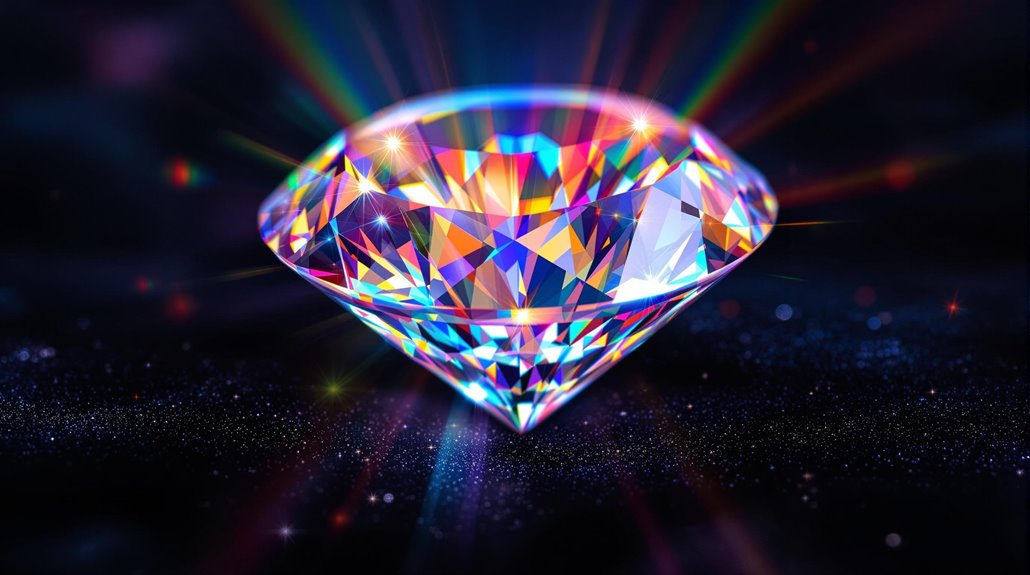Article Contents
- 1 Main Highlights
- 2 Frequently Asked Questions
- 2.1 How Can I Tell if a Diamond Is Real Without Professional Equipment?
- 2.2 Do Lab-Grown Diamonds Sparkle Differently Than Natural Diamonds?
- 2.3 Why Do Some Diamonds Appear Yellow or Slightly Discolored?
- 2.4 Can a Diamond's Sparkle Be Restored if It Becomes Dull?
- 2.5 Does a Diamond's Sparkle Change When Set in Different Colored Metals?
A diamond's dazzling brilliance stems from its unique interplay with light, determined by its cut quality, clarity, and crystalline structure. The jewel's high refractive index and precise faceting work together to create spectacular light performance through internal reflection and dispersion. Superior specimens feature optimal proportions and pristine surfaces that maximize light return, during factors like clarity and color grade influence the stone's ability to produce its signature sparkle. Comprehending these elements reveals the fascinating complexity behind a diamond's captivating display.
Main Highlights
- The precision and quality of a diamond's cut, featuring up to 76 facets, directly impacts its ability to reflect and refract light effectively.
- Superior diamonds possess a high refractive index that optimally slows and splits light into spectral components, creating vibrant sparkle.
- Well-polished facets and minimal internal imperfections allow maximum total internal reflection, enhancing light's path through the diamond.
- Colorless diamonds provide the clearest pathway for light travel, resulting in better brilliance and fire than those with color tints.
- The tetrahedral crystal structure of diamonds enables exceptional light handling capabilities when cut according to ideal proportions.
A diamond's enchanting sparkle represents one of nature's most sophisticated displays of optical physics in action. When light enters a diamond, it undergoes a complex expedition of refraction, bending as it passes through the crystal structure. The diamond's unique optical properties, particularly its high refractive index, cause light to slow down and split into its spectral components, creating the mesmerizing fire that collectors and connoisseurs cherish. The indoor lighting conditions can dramatically affect how a diamond displays its brilliance.
This interaction between light and the diamond's crystalline structure produces the captivating play of colors that distinguishes truly exceptional stones from their less remarkable counterparts. Princess cut diamonds, with their 57 to 76 facets, exemplify how cut complexity enhances brilliance. A well-polished surface ensures the cleanest possible light reflection for maximum sparkle. The refractive index determines how effectively light interacts with the stone's interior structure.
The precision of a diamond's cut serves as the primary determinant of its ability to dazzle. Master cutters carefully shape each facet to precise angles, guaranteeing optimal light performance through the stone. When executed perfectly, these facets work in harmony to capture incoming light, guiding it through the diamond's interior before reflecting it back to the viewer's eye. The GIA cut scale ranges from Excellent to Poor, directly impacting a stone's brilliance and value.
This intricate movement of light relies on the principle of total internal reflection, where light bounces off the internal surfaces of the diamond rather than escaping through its sides.
The underlying crystal structure of diamonds plays a vital role in their remarkable optical performance. The tetrahedral arrangement of carbon atoms creates a lattice that contributes to the stone's legendary hardness but also facilitates its exceptional light-handling capabilities.
This molecular architecture, combined with diamond's inherently high dispersion rate, enables the stone to separate white light into its component colors more effectively than most other gemstones.
Professional jewel experts employ sophisticated tools and standardized grading systems to evaluate a diamond's light performance. The Gemological Institute of America's Four Cs provides a framework for assessment, with particular emphasis on cut quality and clarity.
Advanced instruments like the Ideal Scope and ASET reveal how effectively a diamond handles light, helping experts identify stones that will deliver superior sparkle and brilliance.
The interplay between a diamond's various quality factors determines its ultimate visual performance. Although cut quality remains paramount, factors such as clarity and color significantly influence a stone's ability to handle light effectively.
Higher clarity grades indicate fewer internal imperfections that might otherwise obstruct light's path through the crystal. Similarly, colorless diamonds allow light to pass through unimpeded, maximizing the stone's potential for brilliant light display.
This sophisticated combination of factors explains why certain diamonds command premium prices in the market, as they represent the pinnacle of nature's optical engineering combined with human cutting expertise.
Frequently Asked Questions
How Can I Tell if a Diamond Is Real Without Professional Equipment?
Crystal-clear water test reveals secrets: Drop diamond in water—real ones sink. Combined with fog test, sparkle inspection, and hallmark checks, these visual inspection methods confirm diamond authenticity tests effectively.
Do Lab-Grown Diamonds Sparkle Differently Than Natural Diamonds?
Lab-grown and natural diamonds exhibit identical sparkle characteristics, as they share the same chemical and physical properties. Their brilliance, fire, and scintillation are indistinguishable from one another, even under careful observation.
Why Do Some Diamonds Appear Yellow or Slightly Discolored?
Like a vintage Instagram filter, nitrogen impurities in diamonds create yellow tints, affecting color grading. Diamond fluorescence and atomic-level nitrogen clusters determine these warm hues nature imparts.
Can a Diamond's Sparkle Be Restored if It Becomes Dull?
Regular diamond cleaning can effectively restore a diamond's lost sparkle through gentle cleaning solutions, soft brushing, and proper maintenance techniques. Professional sparkle restoration services are additionally available for deeper treatments.
Does a Diamond's Sparkle Change When Set in Different Colored Metals?
Ever wonder how metal affects a diamond's brilliance? Metal color influences diamond appearance significantly, with white metals enhancing sparkle during yellow and rose gold settings impact stones by imparting warmer hues.

